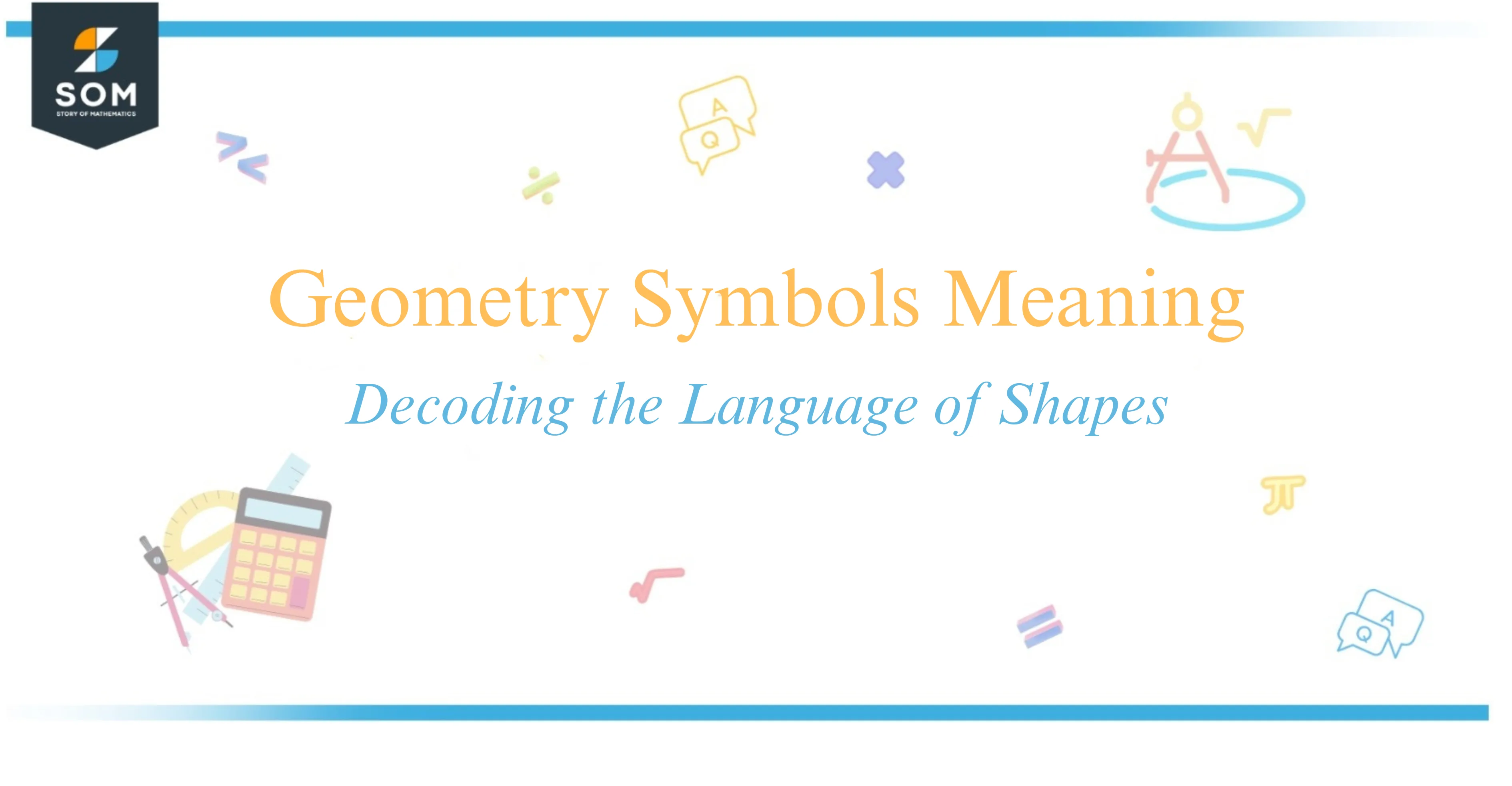JUMP TO TOPIC

Geometry is a branch of mathematics that I’ve always found fascinating. It deals with the properties and relations of points, lines, surfaces, and solids.
The symbols used in geometry are universally recognized shorthand notations that make complex mathematical concepts and proofs easier to understand and communicate. For example, an angle is represented by the symbol $\angle$.
I remember when I first learned that the three sides of a triangle could tell me a lot about its angles and other properties.
Symbolic representation is like the alphabet to the language of mathematics; it’s the key to unlocking the concise expression of mathematical ideas. For example, two figures being similar is denoted by the symbol $\sim$, which conveys that they have the same shape but not necessarily the same size.
Stay tuned, and I’ll guide you through the myriad of symbols that make geometry not just a branch of math, but also an art form in itself.
Basic Geometry Symbols and Their Meanings
In studying geometry, I need to understand the language of shapes, which comes down to various symbols representing the basics like points, lines, segments, and so on.

A point is denoted by a dot and often labeled with a letter. For example, point A is written as ( A ). It represents an exact location in space with no dimensions.
When it comes to a line, I illustrate it with two arrowheads to indicate that it extends infinitely in both directions. If labeled with two points, say A and B, I can write it as $ \overleftrightarrow{AB} $.
A line segment has two endpoints. If those are points A and B, it’s written as $\overline{AB} $. A ray starts at one point and extends infinitely in one direction; for instance, ray AB is $ \overrightarrow{AB} $.
Circling back to angles, I denote an angle with an arc between two rays. If the vertex is at point B and the rays extend to points A and C, it is annotated as $\angle ABC$.
Plane geometry deals with flat shapes like triangles and circles. I symbolize a triangle as $ \triangle $ followed by the vertices’ labels, such as $\triangle ABC$. For a circle, I use the symbol $ \circ $ followed by the center’s label, like $ \circ A$.
Polygons like squares and rectangles are part of this family too. They are named by their shape and the sequence of connected points, creating the boundary.
Below, find a table covering the basic geometric shapes and symbols:
| Shape | Symbol | Example |
|---|---|---|
| Point | Dot | ( A ) |
| Line | Arrows on both ends | $\overleftrightarrow{AB} $ |
| Segment | Endpoints connected | $\overline{AB}$ |
| Ray | Arrow on one end | $\overrightarrow{AB}$ |
| Angle | Arc between rays | $\angle ABC $ |
| Triangle | Triangle symbol | $\triangle ABC$ |
| Circle | Circle symbol | $ \circ A$ |
By familiarizing myself with these symbols, I am able to read and create geometric diagrams more effectively.
Concepts of Congruence and Similarity
When I explore geometry, two of the fundamental concepts I encounter are congruence and similarity.

These concepts apply to geometric figures, such as triangles, and they have precise definitions.
Congruent figures are identical in shape and size. For two shapes to be congruent to each other, all corresponding sides and angles must be equal. When I look at congruent triangles, for example, this equivalence means that:
- Side lengths are equal ($AB = DE$, $BC = EF$, $CA = FD$)
- Angle measures are equal ($\angle A = \angle D$, $\angle B = \angle E$, $\angle C = \angle F$)
| Criteria for Congruent Triangles | Description |
|---|---|
| SSS | All three sides in one triangle are congruent to the corresponding sides of another. |
| SAS | Two sides and the included angle in one triangle are congruent to two sides and the included angle of another. |
| ASA | Two angles and the included side in one triangle are congruent to two angles and the included side of another. |
| AAS | Two angles and a non-included side in one triangle are congruent to two angles and a non-included side of another. |
On the other hand, similarity in geometry refers to figures that have the same shape but not necessarily the same size. If two figures are similar, their corresponding angles are equal, and the sides are in proportion. This can be written as follows:
- The ratio of any two corresponding sides in similar triangles is the same ($\frac{XY}{AB} = \frac{YZ}{BC} = \frac{XZ}{AC}$)
The concept of similarity relies on proportions and scaling. A similar relationship between figures is like a resized version of the same figure. All congruent figures are by default similar, as congruence is a specific type of similarity where the scale factor is one. However, the converse is not true: not all similar figures are congruent.
By understanding congruence and similarity, I can solve various geometry problems by recognizing patterns and applying the right theorems and axioms. These concepts form the backbone of many geometric proofs and applications.
Measurements in Geometry
When I talk about measurements in geometry, I’m referring to the various methods and units used to quantify and describe the size and shape of objects.
In geometry, angles are fundamental, and we measure them in degrees, radians, or gradians. One complete revolution is equal to $360^\circ $ (degrees), $2\pi$ radians, or $400^\text{g} $ (gradians). For more precise measurements, degrees can be broken down into arcminutes and arcseconds, where $1^\circ = 60’$ (arcminutes) and $1′ = 60”$ (arcseconds).
In terms of circular shapes, the circumference is the perimeter around the circle, which can be calculated as $C = 2\pi r$, where ( r ) is the radius. The diameter, twice the radius, is another key term and it relates to the circumference through the pi constant as $ C = \pi d$.
I’ve put together a small table to summarize the symbols and their meanings:
| Symbol | Measure | Description |
|---|---|---|
| $\angle $ | Angle | Represents the figure formed by two rays, called the sides of the angle, sharing a common endpoint. |
| $\pi $ | Pi Constant | A mathematical constant representing the ratio of a circle’s circumference to its diameter; approximately ( 3.14159 ). |
| ( s ) | Arc | A portion of the circumference of a circle. |
| ( l ) | Length | Refers to the measurement of one dimension of an object. |
| ( P ) | Perimeter | The total distance around a two-dimensional shape. |
| ( C ) | Circumference | The distance around a circle. |
| ( r ) | Radius | The distance from the center of a circle to any point on the circumference. |
| ( d ) | Diameter | The distance across a circle through its center is equivalent to ( 2r ). |
By understanding these measurements and their respective symbols, I can effectively communicate and solve geometric problems.
Conclusion
In exploring the language of geometry, I’ve found that the symbols used are essential for communicating complex mathematical ideas succinctly.
The beauty of using symbols like points ($\cdot$), lines ($\overleftrightarrow{AB}$), and angles ($\angle$), among others, is that they provide a universal shorthand that transcends language barriers.
My understanding of various shapes, such as triangles ($\triangle$), circles ($\bigcirc$), and polygons ($n$-gon), has deepened through recognizing the symbols that represent their properties and relationships.
Each symbol has a precise meaning, offering clarity to the propositions and theorems within geometry.
For instance, parallel lines are denoted by ($\parallel$), while a right angle is shown by an iconic square ($\perp$) at the vertex. My grasp of the subject is enhanced by the ability to interpret these symbols and apply them effectively in various geometrical contexts.
Having a clear and well-structured list of geometric symbols and their meanings is invaluable for students, educators, and professionals alike.
It provides a foundation upon which more advanced concepts are built. My journey through geometry has reinforced the idea that mastering the basics, such as the meaning of symbols, is crucial for success in this mathematical domain.
